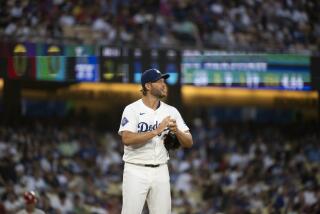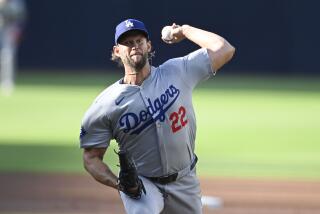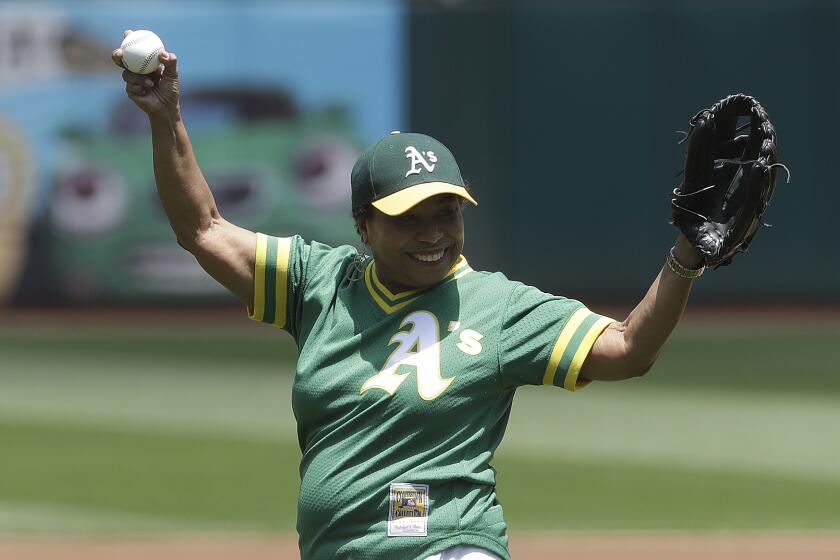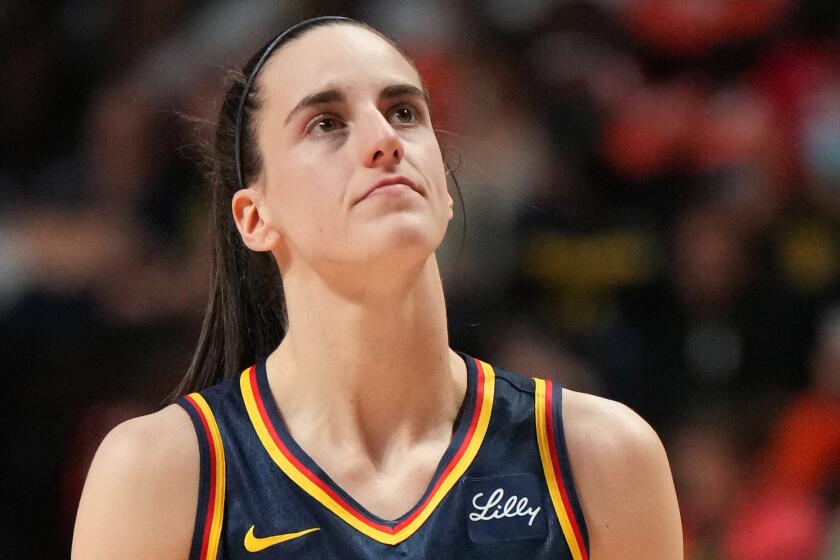Clayton Kershaw makes those Sandy Koufax comparisons plausible
The comparisons were inevitable: He was a young left-hander with a mid-90s fastball and a curveball that froze hitters.
So, on the day Clayton Kershaw was first promoted to the Dodgers’ major league spring training camp in 2008, then-manager Joe Torre simply said what was on everyone else’s mind.
That Kershaw reminded him of Sandy Koufax.
Kershaw was 19 years old.
Torre tried to take it back, but his words were already out.
“Oh, man,” farm director De Jon Watson recalled thinking. “That’s a big word to drop on a kid.”
Don Mattingly, then a coach, now the Dodgers’ manager, had a similar reaction. “That’s not quite fair to the kid,” he said.
Almost four full seasons later, a comparison that once sounded blasphemous — or, at very least, grossly unfair — doesn’t seem so ridiculous.
At 23, Kershaw could be on the verge of his first Cy Young Award. He is scheduled to face the San Francisco Giants and ace Tim Lincecum on Tuesday night at Dodger Stadium, seeking in what will probably be his next-to-last start of the season to become the first Dodgers pitcher since Ramon Martinez in 1990 to win 20 games.
It will be the fourth time this season Kershaw has been matched against Lincecum, who became only the seventh pitcher to win consecutive Cy Youngs when he captured the award in 2008 and ’09. Kershaw has been the winner in each of the first three matchups. The scores: 2-1, 1-0 and 2-1.
Kershaw leads the National League with a 2.30 earned-run average and 236 strikeouts, and through Sunday was tied with Arizona’s Ian Kennedy for the NL lead with 19 wins, with the Diamondbacks right-hander scheduled to face Pittsburgh on Monday night.
If things go just right, Kershaw could become only the second Dodger to win the so-called triple crown of pitching — leading the league in ERA, strikeouts and wins. The first was Koufax, who did it in each of his three Cy Young-winning seasons: 1963, 1965 and 1966.
Shifts in the game present a challenge when comparing players from different eras — for example, Koufax pitched 3352/3 innings in 1965 and 323 in ‘66; Kershaw is projected to finish with a little more than 230 this year. But where Kershaw stands among his contemporaries is comparable to how any of the Dodgers’ previous Cy Young Award winners did among theirs.
Among Dodgers starters to win the award, only Koufax posted an adjusted ERA+ rating higher than Kershaw’s 159, according to baseball-reference.com. (The figure measures how a pitcher’s ERA compares with the league average and is adjusted to negate the effects of a particular ballpark. A rating of 100 is average; the higher the number, the better.)
Koufax posted an adjusted ERA+ of 160 in 1965 and 190 in 1966, his last season. Don Newcombe had an adjusted ERA+ of 132 in 1956, Don Drysdale 127 in 1962, Koufax 159 in 1963, Fernando Valenzuela 135 in 1981 and Orel Hershiser 149 in 1988.
Kershaw appears unaffected by the comparisons, even to Koufax.
“I’m not trying to be anybody else,” he said. “I’ve got expectations for myself to succeed that surpass anybody else’s.”
Torre, who now works for Major League Baseball, said in a telephone interview that he had no doubt Kershaw would reach this level, provided he wasn’t injured.
“It was makeup,” Torre said. “He had No. 1 written all over him. It’s so refreshing to see Kershaw pitch. [His] I-dare-you-to-hit-me type attitude. It’s about being proud of his stuff and not being afraid of hitters.”
Kershaw’s improvement can be attributed to becoming less like Koufax in at least one regard — that is, less reliant on two pitches.
Mattingly said that a couple of years ago, when he was the Dodgers’ hitting coach, pitching coach Rick Honeycutt asked him to watch video of Kershaw and tell him how he would advise a hitter to approach him.
Mattingly’s verdict: Kershaw’s inability to get strike calls with his breaking ball made him essentially a one-pitch pitcher. And because Kershaw had trouble pitching to one side of the plate — away from right-handers and in on left-handers — hitters could key in on one particular area.
Honeycutt relayed the information to Kershaw, who worked to develop a slider — an off-speed pitch he could have called for strikes. He also added a changeup. And he learned to throw to both sides of the plate.
Expanding his repertoire has helped Kershaw develop into an elite pitcher earlier in his career than Koufax did.
Koufax, who broke into the majors with the Brooklyn Dodgers in 1955 at age 19, did not become a regular member of the rotation until 1958, the team’s first year in Los Angeles. By the end of the 1960 season, his sixth, a 24-year-old Koufax had a 36-40 career record and a 4.12 ERA. From 1958-61, his first four seasons as a full-time starter, he averaged 98 walks per year.
Kershaw’s upward curve has been shorter and steeper — in his fourth season, he is 45-28 with a 2.90 ERA.
And as was the case with Koufax, embracing the virtues of control has been a key.
From 2009 to this year Kershaw’s walk rate decreased from 4.8 per nine innings to 3.6 to 2.1, and his wins increased from eight to 13 to 19. Koufax’s walk rate fell from 3.4 in 1961 to 2.8 in 1962, when he posted the first sub-3.00 ERA of his career (2.54) while going 14-7. The next year he won his first Cy Young, going 25-5 with a 1.88 ERA — and walking 58 in 311 innings.
Kershaw’s ability to throw four pitches he can command reminds Mattingly less of Koufax than of David Wells, the bombastic, beer-bellied former New York Yankee.
“Their body types are different and their personalities are different,” Mattingly made sure to add.
But Mattingly said Kershaw’s variety of pitches ensures he will continue to be effective even if his fastball velocity declines as he gets older.
Torre said consistency will determine whether Kershaw takes a place among the greats.
“A lot of times, young guys will have good years and in the back of their minds will say, ‘This isn’t too tough,’ ” Torre said. He doesn’t think that will be an issue with Kershaw, though.
“His priorities are what you want them to be,” Torre said.
Newcombe said he believes Kershaw’s achievements could one day mirror Koufax’s.
“You don’t ever replace a Sandy Koufax; you don’t emulate a Sandy Koufax,” Newcombe said. “But I believe, if you can believe with me, that you will see very soon with the Dodgers another left-hander that parallels maybe a Sandy Koufax in Clayton Kershaw.”
Another Dodgers fixture maintains that comparisons to Koufax are premature.
Former Dodgers manager Tom Lasorda said Kershaw inspires confidence in his teammates the way Hershiser and Valenzuela used to. But Lasorda, who pitched briefly for the Dodgers the year Koufax broke in, said expectations when Koufax took the mound in his prime were completely different.
“When he walked out there, you thought he would strike out 15 guys or throw a perfect game,” Lasorda said.
Of Kershaw, Lasorda said, “Right now, he’s done what he had to do, which is to gain really good control. Let him be his own self, let him win more games, and then start comparing him to the really good guys.”
More to Read
Go beyond the scoreboard
Get the latest on L.A.'s teams in the daily Sports Report newsletter.
You may occasionally receive promotional content from the Los Angeles Times.










